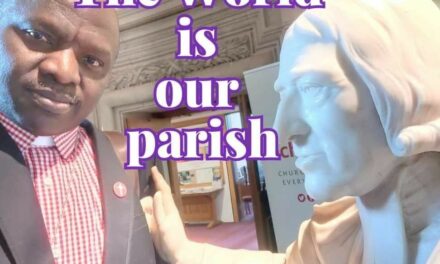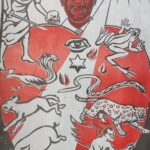Charles Wesley and his brother John Wesley both as itinerant preachers, were major instruments of the Lord’s work during the third great awakening in England. On Sunday, May 21, 1738, after reading Martin Luther’s commentary on Galatians, Charles was converted. He testified, “I now found myself at peace with God, and rejoiced in hope of loving Christ…I saw that by faith I stood; by the continual support of faith.” John was converted three days later. The reflection is that, personal conversion is central and fundamental to Methodism.
John Wesley preached his famous sermon titled “The Almost Christian” in 1741. In the sermon Wesley invites us to follow Jesus Christ wholeheartedly. Magrey DeVega and other co-authors of the book Almost Christmas: A Wesleyan Advent Experience challenged us not to be satisfied with being almost Christian but rather strive towards being altogether a Christian. To do this requires commitment to Christ as we connect our Wesleyan heritage with the traditional Advent themes of Love, Hope, Joy, and Peace. As an evangelist, Wesley understood Jesus’ birth meant good news to people who had lost hope. Wesleyan hymn motifs suggests how to understand and practice Wesleyan heritage and teachings on the essence of Second Birth as preparation for Jesus’ Second Coming. To overcome the barriers that prevent many from experiencing an “altogether” hope, joy, peace and love in Jesus Christ, Wesley’s hymn motifs points us to ‘altogether Christmas’ in claiming God’s eternal promises through His Second Coming.
In Wesley’s hymn motif for Advent is a theology where we find intimations of the salvific work of Jesus Christ, the regeneration of the individual and the eventual renewal of all things. John and Charles Wesley legacies especially their hymn motifs on Advent reflects two main themes namely; Christ’s birth to meet the need for humanity’s spiritual birth and the essence of the second birth for Jesus’ Second Coming. Charles possessed a love and talent for poetry, which he used in the writing of more than 7,000 hymns. He first named it “Hark, how all the welkin ring,” welkin being an archaic English term for the heavens. When George Whitefield published it in 1753, he changed the first line to read, “Hark! The herald angels sing,” and so it has remained that way ever since. Hark! the Herald Angels Sing written in 1739 is a missional theology shaped by rich, biblical message as announced by the angels. The verse three in the hymn ‘Hark the Herald Angels Sings’ articulates the connection between the human’s second birth and Jesus’ Second Coming:
Hail the heav’nly Prince of Peace!
Hail the Sun of Righteousness!
Light and life to all He brings,
Ris’n with healing in His wings.
Mild He lays His glory by,
Born that man no more may die;
Born to raise the sons of earth,
Born to give them second birth
Singing this hymn with understanding without letting the message escape us can be teary and inspires conversion experience. Wesleyan hymns motifs of Advent offers us missional survey of theology and worship as it echoes the names and titles of Jesus Christ: King, Lord, Prince of Peace, Sun of Righteousness, Everlasting Lord, Desire of Nations, Incarnate Deity, and Emmanuel. The theology of Wesleyan hymn motifs for Advent first points to the fact that the promised Messiah has come (Lk 1:5-25; 26-38).
The Wesleyan hymn motifs for Advent reminds us that the eternal God dwells with mortal man, ‘Offspring of virgin’s womb … Veiled in flesh the Godhead see; hail th’incarnate Deity, pleased as man with man to dwell, Jesus, our Emmanuel.” The Wesleyan hymn motifs for Advent reminds us that God is the Author of the new birth as we ‘Hail, the heav’n-born Prince of Peace! Hail, the Sun of Righteousness’ who is ‘Born to raise sons of earth, born to give them second birth.’ The reflection is that it is the Holy Spirit that is responsible for the regeneration of lost, spiritually dead souls or church in the darkroom (Jn 3:8, 1Pet 1:23). It is the righteous God that regenerates unrighteous man and woman.
The theology of Wesleyan hymn motifs for Advent is inspired by the indwelling Christ who provides victory over sin and the devil. Charles declared, ‘Rise, the woman’s conquring seed, bruise in us the serpent’s head.’ The result of this declaration is the indwelling Christ, the Second Adam recreates His image in believers and replaces sin with righteousness. By sin, humanity remains in spiritually dead condition, hence the essence of Jesus’ birth so that we may be raised and prepare for His Second Coming. To be raised from our darkroom of sin, pride, unbelief, ignorance means to be “born from above”, or “born again” or regeneration (Eph 2:1). Charles’ original intention about the hymn above was to be sung to the same tune as his Easter hymn “Christ the Lord is Risen Today.” To Charles, the birth of Christ was missionally connected to His death, resurrection and His Second Coming. Beloved, are you ready for Jesus’ Second Coming? You need to experience the second birth, repent of living and taking pride in sin. Confess your faith in Jesus Christ. Obey the Good News. Bear spiritual fruit, living out truth of God’s Words in anticipation of Jesus’ Second Coming.











Well done Dr. Deji Okegbile. I do pray for more anointing on your ministry. Shalom.
Amen in Jesus name. Thanks